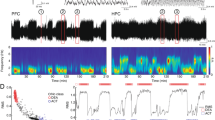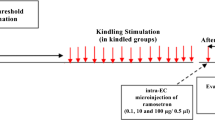Abstract
Although several studies have emphasized a crucial role for the serotonergic system in the control of hippocampal excitability, the role of serotonin (5-HT) and its receptors in normal and pathologic conditions, such as temporal lobe epilepsy (TLE), is still unclear. The present study was therefore designed firstly to investigate the acute effect of 8-OH-DPAT, a mixed 5-HT1A/7 receptor agonist, at a high dose (1 mg/kg, i.p.) known to have antiepileptic properties, in a model of acute partial epilepsy in rats. For this purpose, a maximal dentate activation (MDA) protocol was used to measure electrographic seizure onset and duration. In addition, the effect of 8-OH-DPAT on in vivo dentate gyrus cell reactivity and short- and long-term plasticity was studied. Rats injected with 8-OH-DPAT exhibited a significant reduction in MDA and epileptic discharges, a decrease in paired-pulse facilitation and an increase in long-term potentiation. This study suggests that 8-OH-DPAT or in general 5-HT1A/7 agonists might be useful for the treatment of TLE and also have some beneficial effects on the comorbid cognitive disorders seen in epileptic patients.






Similar content being viewed by others
References
Azmitia EC, Gannon PJ, Kheck NM, Whitaker-Azmitia PM (1996) Cellular localization of the 5-HT1A receptor in primate brain neurons and glial cells. Neuropsychopharmacology 14:35–46
Banasr M, Hery M, Printemps R, Daszuta A (2004) Serotonin-induced increases in adult cell proliferation and neurogenesis are mediated through different and common 5-HT receptor subtypes in the dentate gyrus and the subventricular zone. Neuropsychopharmacology 29:450–460
Bell B, Lin JJ, Seidenberg M, Hermann B (2011) The neurobiology of cognitive disorders in temporal lobe epilepsy. Nat Rev Neurol 7:154–164
Bliss TV, Lomo T (1973) Long-lasting potentiation of synaptic transmission in the dentate area of the anaesthetized rabbit following stimulation of the perforant path. J Physiol 232:331–356
Bliss T, Collingridge G, Morris R (2007) Synaptic plasticity in the hippocampus. In: Pea Andersen (ed) The hippocampus book. Oxford University Press, New York
Bombardi C, Di Giovanni G (2013) Functional anatomy of 5-HT receptors in the amygdala and hippocampal complex: relevance to memory functions. Exp Brain Res. doi:10.1007/s00221-013-3512-6 (in press)
Bortolato M, Pivac N, Mück-Šeler D, Nikolac Perkovic M, Pessia M, Di Giovanni G (2013) The role of the serotonergic system at the interface of aggression and suicide. Neuroscience 236:160–185
Bough KJ, Schwartzkroin PA, Rho JM (2003) Calorie restriction and ketogenic diet diminish neuronal excitability in rat dentate gyrus in vivo. Epilepsia 44:752–760
Brucato FH, Morrisett RA, Wilson WA, Swartzwelder HS (1992) The GABAB receptor antagonist, CGP-35348, inhibits paired-pulse disinhibition in the rat dentate gyrus in vivo. Brain Res 588:150–153
Cagnotto A, Crespi D, Mancini L, Manzoni C, Presti ML, Gariboldi M, Vezzani A, Mennini T (1998) Lasting increase in serotonin 5-HT1A but not 5-HT4 receptor subtypes in the kindled rat dentate gyrus: dissociation from local presynaptic effects. J Neurochem 70:850–857
Chugani DC, Chugani HT (2003) Does serotonin have trophic effects in temporal lobe epilepsy? Neurology 60:736–737
Clinckers R, Smolders I, Meurs A, Ebinger G, Michotte Y (2004) Anticonvulsant action of hippocampal dopamine and serotonin is independently mediated by D2 and 5-HT1A receptors. J Neurochem 89:834–843
Collins RC, Tearse RG, Lothman EW (1983) Functional anatomy of limbic seizures: focal discharges from medial entorhinal cortex in rat. Brain Res 280:25–40
Costa L, Spatuzza M, D’Antoni S, Bonaccorso CM, Trovato C, Musumeci SA, Leopoldo M, Lacivita E, Catania MV, Ciranna L (2012a) Activation of 5-HT7 serotonin receptors reverses metabotropic glutamate receptor-mediated synaptic plasticity in wild-type and Fmr1 knockout mice, a model of Fragile X syndrome. Biol Psychiatry 72:924–933
Costa L, Trovato C, Musumeci SA, Catania MV, Ciranna L (2012b) 5-HT(1A) and 5-HT(7) receptors differently modulate AMPA receptor-mediated hippocampal synaptic transmission. Hippocampus 22:790–801
Crespi F (2010) SK channel blocker apamin attenuates the effect of SSRI fluoxetine upon cell firing in dorsal raphe nucleus: a concomitant electrophysiological and electrochemical in vivo study reveals implications for modulating extracellular 5-HT. Brain Res 1334:1–11
Di Giovanni G, Di Matteo V, Esposito E (eds) (2008) Serotonin–dopamine interaction: experimental evidence and therapeutic relevance. Elsevier, Amsterdam
Freund TF (1992) GABAergic septal and serotonergic median raphe afferents preferentially innervate inhibitory interneurons in the hippocampus and dentate gyrus. Epilepsy Res Suppl 7:79–91
Freund TF, Buzsaki G (1996) Interneurons of the hippocampus. Hippocampus 6:347–470
Freund TF, Gulyas AI, Acsady L, Gorcs T, Toth K (1990) Serotonergic control of the hippocampus via local inhibitory interneurons. Proc Natl Acad Sci USA 87:8501–8505
Garcia CS (2012) Depression in temporal lobe epilepsy: a review of prevalence, clinical features, and management considerations. Epilepsy Res Treat 2012:809843
Gariboldi M, Tutka P, Samanin R, Vezzani A (1996) Stimulation of 5-HT1A receptors in the dorsal hippocampus and inhibition of limbic seizures induced by kainic acid in rats. Br J Pharmacol 119:813–818
Giovacchini G, Toczek MT, Bonwetsch R, Bagic A, Lang L, Fraser C, Reeves-Tyer P, Herscovitch P, Eckelman WC, Carson RE, Theodore WH (2005) 5-HT 1A receptors are reduced in temporal lobe epilepsy after partial-volume correction. J Nucl Med 46:1128–1135
Grzegorzewska M, Mackowiak M, Wedzony K, Hess G (2010) 5-HT1A receptors mediate detrimental effects of cocaine on long-term potentiation and expression of polysialylated neural cell adhesion molecule protein in rat dentate gyrus. Neuroscience 166:122–131
Gulyas AI, Acsady L, Freund TF (1999) Structural basis of the cholinergic and serotonergic modulation of GABAergic neurons in the hippocampus. Neurochem Int 34:359–372
Hedlund PB, Sutcliffe JG (2004) Functional, molecular and pharmacological advances in 5-HT7 receptor research. Trends Pharmacol Sci 25:481–486
Heinemann U, Beck H, Dreier JP, Ficker E, Stabel J, Zhang CL (1992) The dentate gyrus as a regulated gate for the propagation of epileptiform activity. Epilepsy Res Suppl 7:273–280
Jolas T, Schreiber R, Laporte AM, Chastanet M, De Vry J, Glaser T, Adrien J, Hamon M (1995) Are postsynaptic 5-HT1A receptors involved in the anxiolytic effects of 5-HT1A receptor agonists and in their inhibitory effects on the firing of serotonergic neurons in the rat? J Pharmacol Exp Ther 272:920–929
Kanner AM, Balabanov A (2002) Depression and epilepsy: how closely related are they? Neurology 58:S27–S39
Klancnik JM, Baimbridge KG, Phillips AG (1989) Increased population spike amplitude in the dentate gyrus following systemic administration of 5-hydroxytryptophan or 8-hydroxy-2-(di-n-propylamino)tetralin. Brain Res 505:145–148
Klancnik JM, Obenaus A, Phillips AG, Baimbridge KG (1991) The effects of serotonergic compounds on evoked responses in the dentate gyrus and CA1 region of the hippocampal formation of the rat. Neuropharmacology 30:1201–1209
Lacivita E, Leopoldo M, Berardi F, Perrone R (2008) 5-HT1A receptor, an old target for new therapeutic agents. Curr Top Med Chem 8:1024–1034
Lacivita E, Di Pilato P, De Giorgio P, Colabufo NA, Berardi F, Perrone R, Leopoldo M (2012) The therapeutic potential of 5-HT1A receptors: a patent review. Expert Opin Ther Pat 22:887–902
Levkovitz Y, Segal M (1997) Serotonin 5-HT1A receptors modulate hippocampal reactivity to afferent stimulation. J Neurosci 17:5591–5598
Lopez-Meraz ML, Gonzalez-Trujano ME, Neri-Bazan L, Hong E, Rocha LL (2005) 5-HT1A receptor agonists modify epileptic seizures in three experimental models in rats. Neuropharmacology 49:367–375
Lopez-Meraz ML, Martinez A, Rocha L (2007) Effect of 8-OH-DPAT on electrographic activity during the kainic acid-induced status epilepticus in rats. Seizure 16:365–370
Lovenberg TW, Baron BM, de Lecea L, Miller JD, Prosser RA, Rea MA, Foye PE, Racke M, Slone AL, Siegel BW et al (1993) A novel adenylyl cyclase-activating serotonin receptor (5-HT7) implicated in the regulation of mammalian circadian rhythms. Neuron 11:449–458
Misgeld U, Bijak M, Brunner H (1992) Granule cell inhibition and the activity of hilar neurons. Epilepsy Res Suppl 7:113–118
Motamedi GK, Meador KJ (2004) Antiepileptic drugs and memory. Epilepsy Behav 5:435–439
Ogren SO, Eriksson TM, Elvander-Tottie E, D’Addario C, Ekstrom JC, Svenningsson P, Meister B, Kehr J, Stiedl O (2008) The role of 5-HT(1A) receptors in learning and memory. Behav Brain Res 195:54–77
Paxinos G, Watson C (1986) The rat brain in stereotaxic coordinates. Academic Press, Sydney, Australia
Pazos A, Palacios JM (1985) Quantitative autoradiographic mapping of serotonin receptors in the rat brain. I. Serotonin-1 receptors. Brain Res 346:205–230
Radley JJ, Jacobs BL (2003) Pilocarpine-induced status epilepticus increases cell proliferation in the dentate gyrus of adult rats via a 5-HT1A receptor-dependent mechanism. Brain Res 966:1–12
Richter-Levin G, Segal M (1990) Effects of serotonin releasers on dentate granule cell excitability in the rat. Exp Brain Res 82:199–207
Robinson GB, Racine RJ (1986) Interactions between septal and entorhinal inputs to the rat dentate gyrus: facilitation effects. Brain Res 379:63–67
Sakai N, Tanaka C (1993) Inhibitory modulation of long-term potentiation via the 5-HT1A receptor in slices of the rat hippocampal dentate gyrus. Brain Res 613:326–330
Salgado D, Alkadhi KA (1995) Inhibition of epileptiform activity by serotonin in rat CA1 neurons. Brain Res 669:176–182
Salgado-Commissariat D, Alkadhi KA (1997) Serotonin inhibits epileptiform discharge by activation of 5-HT1A receptors in CA1 pyramidal neurons. Neuropharmacology 36:1705–1712
Sanberg CD, Jones FL, Do VH, Dieguez D Jr, Derrick BE (2006) 5-HT1a receptor antagonists block perforant path-dentate LTP induced in novel, but not familiar, environments. Learn Mem 13:52–62
Scharfman HE (ed) (2007) The dentate gyrus: a comprehensive guide to structure, function, and clinical implications. Elsevier, Amsterdam
Sharp T, Hjorth S (1990) Application of brain microdialysis to study the pharmacology of the 5-HT1A autoreceptor. J Neurosci Methods 34:83–90
Stringer JL, Erden F (1995) In the hippocampus in vivo, nitric oxide does not appear to function as an endogenous antiepileptic agent. Exp Brain Res 105:391–401
Stringer JL, Lothman EW (1990a) Maximal dentate activation: a tool to screen compounds for activity against limbic seizures. Epilepsy Res 5:169–176
Stringer JL, Lothman EW (1990b) Use of maximal dentate activation to study the effect of drugs on kindling and kindled responses. Epilepsy Res 6:180–186
Stringer JL, Lothman EW (1992) Reverberatory seizure discharges in hippocampal–parahippocampal circuits. Exp Neurol 116:198–203
Stringer JL, Sowell KL (1994) Kainic acid, bicuculline, pentylenetetrazol and pilocarpine elicit maximal dentate activation in the anesthetized rat. Epilepsy Res 18:11–21
Stringer JL, Williamson JM, Lothman EW (1989) Induction of paroxysmal discharges in the dentate gyrus: frequency dependence and relationship to afterdischarge production. J Neurophysiol 62:126–135
Theodore WH (2003) Does serotonin play a role in epilepsy? Epilepsy Curr 3:173–177
Theodore WH, Hasler G, Giovacchini G, Kelley K, Reeves-Tyer P, Herscovitch P, Drevets W (2007) Reduced hippocampal 5HT1A PET receptor binding and depression in temporal lobe epilepsy. Epilepsia 48:1526–1530
Theodore WH, Wiggs EA, Martinez AR, Dustin IH, Khan OI, Appel S, Reeves-Tyer P, Sato S (2012) Serotonin 1A receptors, depression, and memory in temporal lobe epilepsy. Epilepsia 53:129–133
Tokarski K, Zahorodna A, Bobula B, Hess G (2002) Comparison of the effects of 5-HT1A and 5-HT4 receptor activation on field potentials and epileptiform activity in rat hippocampus. Exp Brain Res 147:505–510
Wada Y, Nakamura M, Hasegawa H, Yamaguchi N (1992) Role of serotonin receptor subtype in seizures kindled from the feline hippocampus. Neurosci Lett 141:21–24
Wada Y, Nakamura M, Hasegawa H, Yamaguchi N (1993) Intra-hippocampal injection of 8-hydroxy-2-(di-n-propylamino)tetralin (8-OH-DPAT) inhibits partial and generalized seizures induced by kindling stimulation in cats. Neurosci Lett 159:179–182
Watanabe K, Minabe Y, Ashby CR Jr, Katsumori H (1998) Effect of acute administration of various 5-HT receptor agonists on focal hippocampal seizures in freely moving rats. Eur J Pharmacol 350:181–188
White HS (2002) Animal models of epileptogenesis. Neurology 59:S7–S14
Acknowledgments
This study was supported by University of Malta research funding scheme, coordinator G. Di Giovanni. G.O. is supported by MIUR, Italy.
Author information
Authors and Affiliations
Corresponding authors
Rights and permissions
About this article
Cite this article
Orban, G., Pierucci, M., Benigno, A. et al. High dose of 8-OH-DPAT decreases maximal dentate gyrus activation and facilitates granular cell plasticity in vivo. Exp Brain Res 230, 441–451 (2013). https://doi.org/10.1007/s00221-013-3594-1
Received:
Accepted:
Published:
Issue Date:
DOI: https://doi.org/10.1007/s00221-013-3594-1




